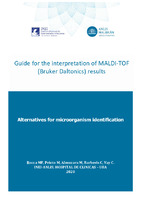Use este identificador para citar ou linkar para este item:
http://sgc.anlis.gob.ar/handle/123456789/1526| Título: | Guide for the interpretation of MALDI-TOF (Bruker Daltonics) results: Alternatives for microorganism identification | Autor(es): | Rocca, María Florencia Prieto, Mónica A. Almuzara, Marisa Barberis, Claudia Vay, Carlos Viñes, María Pilar |
Palavras-chave: | Espectrometría de Masa por Láser de Matriz Asistida de Ionización Desorción;Espectrometría de Masas;Microbiología;Manual de Referencia | Data do documento: | Mar-2020 | Editora: | ANLIS Dr.C.G.Malbrán; UBA | Resumo: | This is the 2nd. Edition of the Manual, is the product of an arduous work of validation of the performance of the commercial platforms of mass spectrometry (Microflex LT and Vitek MS) carried out by the Bacteriology Service of the Department of Clinical Biochemistry of the Hospital de Clínicas “José de San Martín of the Faculty of Pharmacy and Biochemistry of the University of Buenos Aires and the Special Bacteriology service of the Department of Bacteriology of the National Institute of Infectious Diseases ANLIS "Dr. Carlos Malbrán ”The contents of this Manual include information on the limitations of the method, different techniques for sample preparation, recommendations for the interpretation of the identification results, new score values accepted and validated by the National Reference Laboratories, among others. . This manual was carefully designed with the main objective of preparing reports with a unified criteria that provide the most clinically relevant data for patient management. It also includes information on the suggested molecular methods for reference identification and algorithms and tables with phenotypic markers that were exclusively designed to complement and confirm those results that could present ambiguity. Thus, an easily accessible tool is offered for professionals in clinical bacteriology laboratories, where the different genera and species of clinical importance are described in alphabetical order. Free access to this Manual will allow all laboratories of less complexity, to have the certainty that the information obtained with this new technology is reliable and validated by national reference laboratories. |
Descrição: | Fil: Rocca, MF. ANLIS Dr.C.G.Malbrán. Instituto Nacional de Enfermedades Infecciosas. Departamento de Bacteriología. Servicio de Bacteriología Especial; Argentina. Fil: Prieto, MF ANLIS Dr.C.G.Malbrán. Instituto Nacional de Enfermedades Infecciosas. Departamento de Bacteriología. Servicio de Bacteriología Especial; Argentina. Fil: Almuzara, M. Laboratorio de Bacteriología, Departamento de Bioquímica Clínica, Hospital de Clínicas José de San Martín, Facultad de Farmacia y Bioquímica, Universidad de Buenos Aires, Buenos Aires, Argentina. Fil: Barberis, C. Laboratorio de Bacteriología, Departamento de Bioquímica Clínica, Hospital de Clínicas José de San Martín, Facultad de Farmacia y Bioquímica, Universidad de Buenos Aires, Buenos Aires, Argentina. Fil: Vay C. Laboratorio de Bacteriología, Departamento de Bioquímica Clínica, Hospital de Clínicas José de San Martín, Facultad de Farmacia y Bioquímica, Universidad de Buenos Aires, Buenos Aires, Argentina. Fil: Viñes, M. Laboratorio de Bacteriología, Departamento de Bioquímica Clínica, Hospital de Clínicas José de San Martín, Facultad de Farmacia y Bioquímica, Universidad de Buenos Aires, Buenos Aires, Argentina. |
metadata.dc.relation.isversionof: | http://sgc.anlis.gob.ar/handle/123456789/1525 | URI: | http://sgc.anlis.gob.ar/handle/123456789/1526 | Direitos: | Open access Creative Commons Attribution 4.0 International License |
| Aparece nas Coleções: | Publicaciones INEI |
Arquivos neste item:
| Arquivo | Descrição | Tamanho | Formato | |
|---|---|---|---|---|
| 2020-manual-malditof-ENG.pdf | 3.76 MB | Adobe PDF |  Ver/Aberto |
Visualização de página
512
Checado em 13/12/2025
Download(s)
34
Checado em 13/12/2025
Google ScholarTM
Checar
Este item está licenciada sob uma Licença Creative Commons


